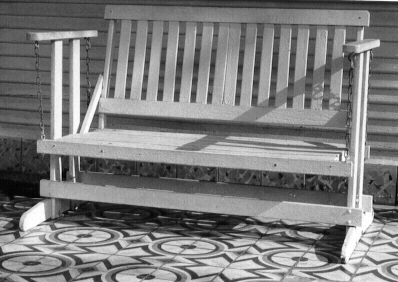Porch Gliders
Today, we build a chair for a front-porch America. The University of Houston's College of Engineering presents this series about the machines that make our civilization run, and the people whose ingenuity created them.
A few years ago I picked up a fifty-dollar kit -- a large box of precut redwood boards and brass fittings. When I assembled it, I had a glider-style love-seat. The motion of a glider seat is very comfortable. And for a good reason. It has to do with your semicircular canals!
Any time you turn your head while your body is moving in a curved path, you activate something called a Coriolis force in the fluid of your inner ear. That force moves the fluid in a deceptive way. It sends a wrong signal to your brain. It makes you think you aren't moving the way your eyes say you are.
The result is motion sickness. If you suffer motion sickness, the worst thing you can do is to turn your head in a lurching car or plane. That's also true in a swing -- on the playground or on your front porch. I'm very bad that way. Who doesn't love to be in motion; but even rocking chairs bother me.
Now Margaret Culbertson writes about porch gliders. They use a simple but subtle mechanism to avoid curved motion. The seat hangs in a frame. The front and back swing from different points. The seat stays nearly level as it moves to and fro.
The word glider fits. The seat really does seem to glide. The motion is nearly straight, and it doesn't bother your stomach. Besides, you can move it around like any other piece of furniture. It isn't nailed to the ceiling or tied to a tree branch.
Culbertson finds the first precursor to the glider in an 1898 Ladies Home Journal. From then until 1925 inventors varied the theme and used names like "Couch Hammock," and "Swinging Davenport." This was, after all, America's front-porch era.
By the late '20s, the glider found its present form. In 1925 an inventor also found the right word to describe it. When he called his version the "Glide Hammock," he added the word glider to our vocabulary.
Some very fancy gliders appeared in the 1930s. Frank Lloyd Wright used them. You could even buy a hideaway bed in glider form. Then something changed in America.
We moved off our porches. We became a peripatetic people -- no longer facing outward toward our neighbors. Our lives take us far from our homes and our TV and air conditioning take us indoors. We are no longer a front-porch people.
So I look for my wife in the early morning. I find her drinking coffee in that wooden glider. But now it's in the back yard -- away from the overstimulation that drives us all to privacy. In the glider, she can turn her head this way and that in perfect comfort. But she turns to see robins and roses, cats and chameleons -- instead of neighbors and passers-by.
I'm John Lienhard, at the University of Houston, where we're interested in the way inventive minds work.
(Theme music)
Culbertson, M., E-Z Glider, Cite, Spring, 1992, pp. 30-32.
I don't have a citation for the mechanisms of motion sickness. Colleagues in the Wenner-Gren Aeronautical Laboratory at the University of Kentucky told me about that during the late 1960s. Working under contract with NASA, they studied motion sickness among primates in large centrifuges. They explained to me how the Coriolis force worked in the inner ear.

Photo by Margaret Culbertson
A typical porch glider